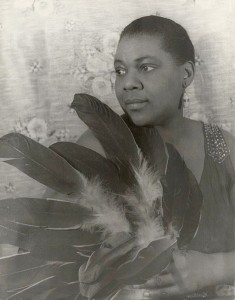Bessie Smith, singer (Black History Month)
Bessie Smith was the most popular female blues singer of the 1920s and 1930s, known as the Empress of the Blues, and was a major influence on subsequent jazz vocalists. Bent Alaska presents her story as part of our celebration of Black History Month 2012, with thanks to GLAAD and the Equality Forum.
Bessie Smith
 “It’s a long old road, but I know I’m gonna find the end.”
“It’s a long old road, but I know I’m gonna find the end.”
Bessie Smith (born July 1892 or April 15, 1894; died September 26, 1937) was the most popular female blues singer of the 1920s and 1930s, known as the Empress of the Blues, and was a major influence on subsequent jazz vocalists.
Details of Bessie Smith ‘s childhood, including the year of her birth, vary. Both Smith’s parents died before her ninth birthday. To help support their impoverished family, she and her brother Andrew as children busked on the streets of Chattanooga, Tennessee, singing and dancing, he accompanying her on guitar.
In 1912, Smith joined a traveling troupe, where she met Ma Rainey, one of the earliest known professional blues singers, who became Smith’s friend and mentor. Smith’s extraordinary talent as a blues singer, coupled with her vivacious personality, quickly landed her a solo act in Atlanta, Georgia. She entered the Eastern Seaboard vaudeville circuit and over the next ten years her popularity soared.
By 1923, Smith had taken up residence in Philadelphia, where she met and married Jack Gee, a security guard, on June 7, 1923, just as her first record, “Down-Hearted Blues,” was released with Columbia Records, catapulting her to national success. She became the highest paid black entertainer of the day, earning up to $2000 per week at the height of her career, touring in her own railroad car and heading her own shows, which sometimes featured as many as 40 troupers. Most of her records were issued on Columbia Records “race records” series marketed especially for black audiences.
Her relationship with Gee was a stormy one, and there were infidelities on both sides, including Smith’s affairs with other women. Smith ended the relationship with Gee in 1929, though neither sought divorce. She later entered a relationship with Richard Morgan, who was with her through the rest of her life.
Smith toured the country recording over 160 songs
accompanied by some of the greatest jazz instrumentalists of the day, notably Louis Armstrong, James P. Johnson, Joe Smith, Charlie Green, and Fletcher Henderson. From slow blues to jazz standards, Bessie Smith consistently produced original work, demonstrating her broad range and versatility. According to a biography written for the Ken Burns film Jazz for PBS,
Smith was unquestionably the greatest of the vaudeville blues singers and brought the emotional intensity, personal involvement, and expression of blues singing into the jazz repertory with unexcelled artistry. Baby Doll and After You’ve Gone, both made with Joe Smith, and Nobody Knows You When You’re Down And Out, with Ed Allen on cornet, illustrate her capacity for sensitive interpretation of popular songs. Her broad phrasing, fine intonation, blue-note inflections, and wide, expressive range made hers the measure of jazz-blues singing in the 1920s. She made almost 200 recordings, of which her remarkable duets with Armstrong are among her best. Although she excelled in the performance of slow blues, she also recorded vigorous versions of jazz standards. Joe Smith was her preferred accompanist, but possibly her finest recording (and certainly the best known in her day) was Back Water Blues, with James P. Johnson. Her voice had coarsened by the time of her last session, but few jazz artists have been as consistently outstanding as she.
Five years after signing with Columbia Records, Smith’s career began to decline, partly from alcoholism, partly because of the Great Depression, which all but ended the recording industry, and partly because of the advent of “talkies” (films with sound), which led to decline of vaudeville. She made her only film appearance in 1929, starring in a two-reeler titled St. Louis Blues, a dramatization of the W. C. Handy song of the same name, which Smith had made a hit recording of in 1925. Smith’s last recording, featuring Benny Goodman, was made in 1933.
Smith continued to perform in clubs up until her death. On September 26, 1937, she was critically injured in a car accident while traveling along between Memphis, and Clarksdale, Mississippi with her lover Richard Morgan. She died a few hours later of her injuries. Her funderal, held in Philadelphia on October 4, 1937, was attended by about seven thousand people, according to contemporary press accounts. Her grave remained unmarked until August 7, 1970, when a tombstone paid for by singer Janis Joplin and Juanita Green, who as a child had done housework for Smith was erected.
Three recordings of Bessie Smith — “Empty Bed Blues” (recorded 1928), “St. Louis Blues” (recorded 1925), and “Downhearted Blues” (recorded 1923) — were inducted into the Grammy Hall of Fame, a special Grammy Award established in 1973 to honor recordings that are at least 25 years old and that have “qualitative or historical significance.” Recordings of her music continue to be widely available, and she is the subject of several biographies, including Bessie
by Chris Albertson (2003).
Watch a clip from her 1929 movie, St. Louis Blues:
For more about Bessie Smith, visit her LGBT History Month page, or Wikipedia article.






















